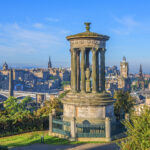MORE FROM SCOTLAND MAGAZINE
St Giles’ Cathedral: 900 years
We tell the story of the iconic St Giles’ Cathedral in Edinburgh in its 900th anniversary year
Words by Kirsten Henton
This year marks the 900th anniversary of the founding of St Giles’ Cathedral, the High Kirk of Edinburgh. This leading Presbyterian church, an unofficial and bishop-free cathedral, is now a major tourist attraction in Edinburgh and the heart of a thriving local community. Here we take a look at its fascinating past.
The early history of St Giles’ Cathedral
Believed to have been founded by David I of Scotland in 1124, when Catholicism was Scotland’s default religion, St Giles’ Cathedral was established as a kirk (or church) within an existing parish, that of St Cuthbert’s Church, thought to be the oldest Christian site in the city.
“We think Saint Giles was chosen to be the patron because he was an important saint for the house of Dunkeld, home of Scotland’s royal family,” says tour guide, Robin McCaig.
The popular medieval patron of lepers and beggars was also “one of Scotland’s early patron saints before St Andrew,” he says, and remains patron saint of Edinburgh to this day.
From church to cathedral St Giles’ was eventually raised to collegiate status by Pope Paul II in 1466. However, within a century, the Reformation upended religion in Scotland and in 1559, the chief reformer John Knox became the first Presbyterian Minister of St Giles’, ahead of the official 1560 parliamentary decree declaring Scotland a Protestant nation.

Although Scotland’s monarch Mary, Queen of Scots was Catholic, the country no longer followed Catholicism and neither, after more than 400 years, did St Giles’. In fact, for its significant part in the Reformation, St Giles’ became known as ‘the Mother Church of World Presbyterianism’.
A new period of religious tensions followed the union of the crowns in 1603 during the reign of James VI & I. In 1633, his son, Charles I, sought to bring the Presbyterian Church of Scotland in line with the Anglican Church of England; he rashly created a new diocese of Edinburgh and appointed a new bishop. The first and last time the new prayer book was used at St Giles’ on 23 July 1637, a local woman, Jenny Geddes, threw a stool at the minister’s head, sparking a riot. This led to the formation of the National Covenant and ultimately the Wars of the Three Kingdoms, which raged from 1639 to 1653.
St Giles’ was officially classed as a cathedral twice between 1633 and 1638, and again following the restoration of Charles II from 1661 until 1689. William III finally abolished St Giles’ episcopacy in 1690. As such, St Giles’ hasn’t actually held official cathedral status since the late 17th century
but has managed to keep the title and its High Kirk of Edinburgh label.
The architecture of St Giles’ Cathedral
The kirk seen today is a multi-layered concoction of architectural styles. As Ian Hannah, academic and politician, wrote in 1934: “No other Scottish church has so tangled an architectural history.”
The original, far smaller, 12th-century Romanesque-style church was constructed largely of pink sandstone and grey whinstone. Much of this was lost in the fires of 1322 and 1385, both ignited by acts of aggression from English kings. It was during the latter part of the 14th century that St Giles’ was reincarnated in its Gothic form.

Various tweaks occurred over the centuries including raising the roof and adding naves, chapels, the choir and the tower with its iconic crown steeple, which remarkably hosted nesting storks in the 15th century. As Professor Richard Fawcett, an expert in medieval architecture, wrote, there were “almost haphazard addition[s]” which created “an extraordinarily complex plan.”
Following the Reformation, the interior was partitioned with stone walls to meet the needs of numerous congregations. By 1699, St Giles’ embodied four churches in one while also acting, in part, as a prison, and a meeting place for Parliament and other secular activities, which all affected its layout.
The most significant changes came with the William Burn Restoration of 1829 to 1833 when the church was encased in the grey sandstone visible today; and in 1871, when William Hay, hired by Sir William Chambers, removed the partition walls.
New stained-glass windows arrived during the Victorian period and into the early 20th century, while the most significant development of the last century included the addition of the ornate Thistle Chapel.
Thistle Chapel

Constructed in 1911, this private chapel is the opulent home of the Order of the Thistle. The order, formed of 16 knights and ladies led by the sovereign, is the most prestigious order in Scotland. Although thought to have originated in the 15th century, if not earlier, the current order dates from 1687 during the reign of King James VII.
The chapel is small and the wood dark with a heavy atmosphere but the detail is astonishing. From the remarkable stone ceiling, colourful clan plaques and pews carved from Scottish oak to the sandstone walls and floor inlaid with granite and marble, it’s packed with symbolism, including St Giles’ now-famous carved angels with bagpipes.
St Giles’ Cathedral today
The Edinburgh of today is completely unrecognisable from the one in which St Giles’ Cathedral was founded at the eastern edge of the city’s limits. It has evolved through 900 years of change, much of it turbulent.
From the Reformation and union to wars civil and beyond, it has also hosted countless religious and royal ceremonies. Most recently, Queen Elizabeth II lay in state while some 33,000 people streamed through its doors to pay their respects to Britain’s longest-serving monarch.
However, it’s not all about what has been. Interim moderator and locum minister Reverend Dr George Whyte says of the anniversary: “We’re trying to look forward. We’re using the occasion to stretch for the future as well as celebrate the past.” To this end, the kirk is hosting numerous events and displays for all to experience.
Writing in 1889, minister and author James Cameron Lees said of St Giles’ famous steeple: “Edinburgh would not be Edinburgh without it,” a sentiment that rings true today and inevitably will in centuries to come, too.
Find out about St Giles’ Cathedral’s anniversary events at stgilescathedral.org.uk/900
Read more in the July/August 2024 issue. Available to buy from Friday 14 June here.
Read more from Scotland Magazine:

SCOTLAND MAGAZINE
Published six times a year, every issue of Scotland showcases its stunning landscapes and natural beauty, and delves deep into Scottish history. From mysterious clans and famous Scots (both past and present), to the hidden histories of the country’s greatest castles and houses, Scotland‘s pages brim with the soul and secrets of the country.
Scotland magazine captures the spirit of this wild and wonderful nation, explores its history and heritage and recommends great places to visit, so you feel at home here, wherever you are in the world.












